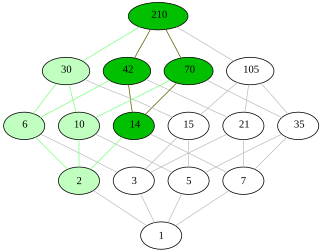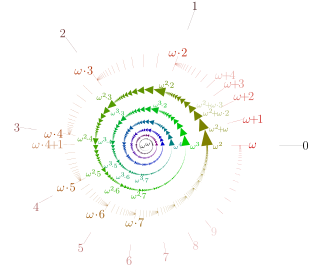| Part of a series on statistics |
| Probability theory |
|---|
 |
In mathematics, a singleton, also known as a unit set [1] or one-point set, is a set with exactly one element. For example, the set is a singleton whose single element is .
| Part of a series on statistics |
| Probability theory |
|---|
 |
In mathematics, a singleton, also known as a unit set [1] or one-point set, is a set with exactly one element. For example, the set is a singleton whose single element is .
Within the framework of Zermelo–Fraenkel set theory, the axiom of regularity guarantees that no set is an element of itself. This implies that a singleton is necessarily distinct from the element it contains, [1] thus 1 and {1} are not the same thing, and the empty set is distinct from the set containing only the empty set. A set such as is a singleton as it contains a single element (which itself is a set, however, not a singleton).
A set is a singleton if and only if its cardinality is 1. In von Neumann's set-theoretic construction of the natural numbers, the number 1 is defined as the singleton
In axiomatic set theory, the existence of singletons is a consequence of the axiom of pairing: for any set A, the axiom applied to A and A asserts the existence of which is the same as the singleton (since it contains A, and no other set, as an element).
If A is any set and S is any singleton, then there exists precisely one function from A to S, the function sending every element of A to the single element of S. Thus every singleton is a terminal object in the category of sets.
A singleton has the property that every function from it to any arbitrary set is injective. The only non-singleton set with this property is the empty set.
Every singleton set is an ultra prefilter. If is a set and then the upward of in which is the set is a principal ultrafilter on [2] Moreover, every principal ultrafilter on is necessarily of this form. [2] The ultrafilter lemma implies that non-principal ultrafilters exist on every infinite set (these are called free ultrafilters ). Every net valued in a singleton subset of is an ultranet in
The Bell number integer sequence counts the number of partitions of a set ( OEIS: A000110 ), if singletons are excluded then the numbers are smaller ( OEIS: A000296 ).
Structures built on singletons often serve as terminal objects or zero objects of various categories:
Let S be a class defined by an indicator function
Then S is called a singleton if and only if there is some such that for all
The following definition was introduced by Whitehead and Russell [3]
The symbol ‘ denotes the singleton and denotes the class of objects identical with aka . This occurs as a definition in the introduction, which, in places, simplifies the argument in the main text, where it occurs as proposition 51.01 (p.357 ibid.). The proposition is subsequently used to define the cardinal number 1 as
That is, 1 is the class of singletons. This is definition 52.01 (p.363 ibid.)

In mathematics, the axiom of choice, abbreviated AC or AoC, is an axiom of set theory equivalent to the statement that a Cartesian product of a collection of non-empty sets is non-empty. Informally put, the axiom of choice says that given any collection of sets, each containing at least one element, it is possible to construct a new set by arbitrarily choosing one element from each set, even if the collection is infinite. Formally, it states that for every indexed family of nonempty sets, there exists an indexed set such that Failed to parse : x_{i}\in S_{i} for every . The axiom of choice was formulated in 1904 by Ernst Zermelo in order to formalize his proof of the well-ordering theorem.

In abstract algebra, a Boolean algebra or Boolean lattice is a complemented distributive lattice. This type of algebraic structure captures essential properties of both set operations and logic operations. A Boolean algebra can be seen as a generalization of a power set algebra or a field of sets, or its elements can be viewed as generalized truth values. It is also a special case of a De Morgan algebra and a Kleene algebra.

In mathematics, the empty set is the unique set having no elements; its size or cardinality is zero. Some axiomatic set theories ensure that the empty set exists by including an axiom of empty set, while in other theories, its existence can be deduced. Many possible properties of sets are vacuously true for the empty set.

In mathematics, a filter or order filter is a special subset of a partially ordered set (poset), describing "large" or "eventual" elements. Filters appear in order and lattice theory, but also topology, whence they originate. The notion dual to a filter is an order ideal.
In mathematical logic, the Peano axioms, also known as the Dedekind–Peano axioms or the Peano postulates, are axioms for the natural numbers presented by the 19th-century Italian mathematician Giuseppe Peano. These axioms have been used nearly unchanged in a number of metamathematical investigations, including research into fundamental questions of whether number theory is consistent and complete.
In the mathematical field of category theory, the category of sets, denoted as Set, is the category whose objects are sets. The arrows or morphisms between sets A and B are the total functions from A to B, and the composition of morphisms is the composition of functions.
In mathematics, a topological space is, roughly speaking, a geometrical space in which closeness is defined but cannot necessarily be measured by a numeric distance. More specifically, a topological space is a set whose elements are called points, along with an additional structure called a topology, which can be defined as a set of neighbourhoods for each point that satisfy some axioms formalizing the concept of closeness. There are several equivalent definitions of a topology, the most commonly used of which is the definition through open sets, which is easier than the others to manipulate.

In the mathematical field of order theory, an ultrafilter on a given partially ordered set is a certain subset of namely a maximal filter on that is, a proper filter on that cannot be enlarged to a bigger proper filter on
In topology, a discrete space is a particularly simple example of a topological space or similar structure, one in which the points form a discontinuous sequence, meaning they are isolated from each other in a certain sense. The discrete topology is the finest topology that can be given on a set. Every subset is open in the discrete topology so that in particular, every singleton subset is an open set in the discrete topology.
In set theory, the kernel of a function may be taken to be either
In mathematics, the category of topological spaces, often denoted Top, is the category whose objects are topological spaces and whose morphisms are continuous maps. This is a category because the composition of two continuous maps is again continuous, and the identity function is continuous. The study of Top and of properties of topological spaces using the techniques of category theory is known as categorical topology.

In category theory, a natural numbers object (NNO) is an object endowed with a recursive structure similar to natural numbers. More precisely, in a category E with a terminal object 1, an NNO N is given by:
In mathematical logic, a Boolean-valued model is a generalization of the ordinary Tarskian notion of structure from model theory. In a Boolean-valued model, the truth values of propositions are not limited to "true" and "false", but instead take values in some fixed complete Boolean algebra.

In mathematics, an upper set of a partially ordered set is a subset with the following property: if s is in S and if x in X is larger than s, then x is in S. In other words, this means that any x element of X that is to some element of S is necessarily also an element of S. The term lower set is defined similarly as being a subset S of X with the property that any element x of X that is to some element of S is necessarily also an element of S.
This article examines the implementation of mathematical concepts in set theory. The implementation of a number of basic mathematical concepts is carried out in parallel in ZFC and in NFU, the version of Quine's New Foundations shown to be consistent by R. B. Jensen in 1969.
Tarski–Grothendieck set theory is an axiomatic set theory. It is a non-conservative extension of Zermelo–Fraenkel set theory (ZFC) and is distinguished from other axiomatic set theories by the inclusion of Tarski's axiom, which states that for each set there is a Grothendieck universe it belongs to. Tarski's axiom implies the existence of inaccessible cardinals, providing a richer ontology than ZFC. For example, adding this axiom supports category theory.
In mathematics, a topos is a category that behaves like the category of sheaves of sets on a topological space. Topoi behave much like the category of sets and possess a notion of localization; they are a direct generalization of point-set topology. The Grothendieck topoi find applications in algebraic geometry; the more general elementary topoi are used in logic.

In set theory, an ordinal number, or ordinal, is a generalization of ordinal numerals aimed to extend enumeration to infinite sets.
In mathematics, a convergence space, also called a generalized convergence, is a set together with a relation called a convergence that satisfies certain properties relating elements of X with the family of filters on X. Convergence spaces generalize the notions of convergence that are found in point-set topology, including metric convergence and uniform convergence. Every topological space gives rise to a canonical convergence but there are convergences, known as non-topological convergences, that do not arise from any topological space. Examples of convergences that are in general non-topological include convergence in measure and almost everywhere convergence. Many topological properties have generalizations to convergence spaces.

In the mathematical field of set theory, an ultrafilter on a set is a maximal filter on the set In other words, it is a collection of subsets of that satisfies the definition of a filter on and that is maximal with respect to inclusion, in the sense that there does not exist a strictly larger collection of subsets of that is also a filter. Equivalently, an ultrafilter on the set can also be characterized as a filter on with the property that for every subset of either or its complement belongs to the ultrafilter.